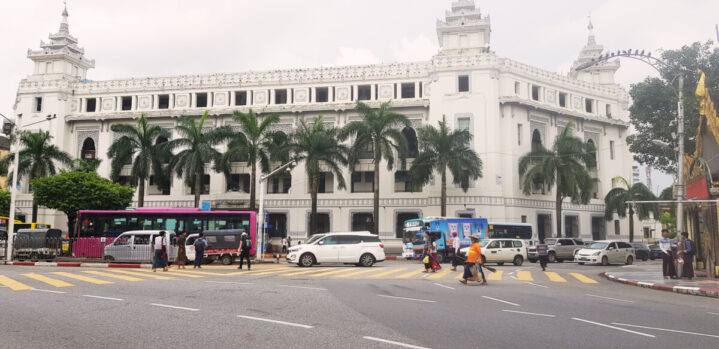
It’s Friday, it must be Myanmar… or is it?
The Irish and the Chinese have long been itinerant travellers to different parts of the world, to different climes and cultures. But while you are very likely to find an Irish hostelry to serve you up a cool glass of Guinness as you progress around the planet, you are unlikely to find an ‘Irishtown’. Many cities around the world, however, have a ‘Chinatown’, and Burma (now known as Myanmar) is no exception, and has its very own Chinatown (Tayoke Tan) in Rangoon (now known as Yangon).
But the best place to start is at the beginning, so let’s do just that. Myanmar has only really been open to tourism for less than ten years, as the country was previously run by a restrictive military dictatorship. Democratic elections were held, and came into power, although the military still hold a significant amount of control, even now. However, the country desperately needs the tourist dollars it has missed out on for so long, and Myanmar now welcomes tourists with open arms. In fact, the online e-visa is one of the simplest and most convenient I have ever encountered.
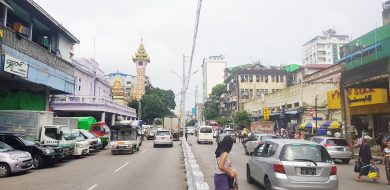 The ageing military rule era airport was demolished in 2016, and in its place now stands a modern, welcoming international arrival and departure hall. I have lived in Thailand for many years – one of the world’s top tourist destinations, with always long queues, and it was a welcome change to breeze through Myanmar Immigration in only a few minutes. After arrival, if you need to spike up your smartphone with a local sim card, there are several booths around that will quickly fix you up for less than five dollars. So, let’s say that on this trip you are going to check out Chinatown and its environs. If you only have USD, expect to pay around 10USD to Lattha Township in a taxi (where Chinatown can be found), or if you have Myanmar Kyat you can get away with 8 to 10,000.
The ageing military rule era airport was demolished in 2016, and in its place now stands a modern, welcoming international arrival and departure hall. I have lived in Thailand for many years – one of the world’s top tourist destinations, with always long queues, and it was a welcome change to breeze through Myanmar Immigration in only a few minutes. After arrival, if you need to spike up your smartphone with a local sim card, there are several booths around that will quickly fix you up for less than five dollars. So, let’s say that on this trip you are going to check out Chinatown and its environs. If you only have USD, expect to pay around 10USD to Lattha Township in a taxi (where Chinatown can be found), or if you have Myanmar Kyat you can get away with 8 to 10,000.
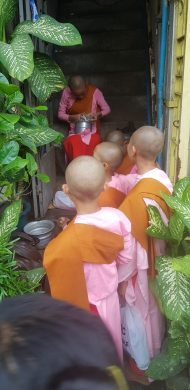
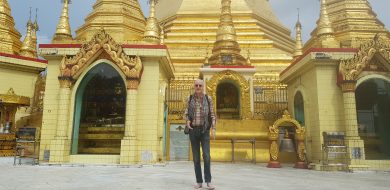 There are plenty of hotels to choose from, covering all price ranges. I usually stay in the Hotel Grand United on 21st Street… it’s about 40USD a night, and the buffet breakfast is great. Sets you up for all day long, with the added bonus of a rooftop restaurant and terrace that gives you a great view over Chinatown and the rest of the city. Yangon’s Chinatown was established by British colonials in the 1800s, and is home today to a diverse group of overseas Chinese who can mostly trace their roots back to the southernmost Chinese provinces of Guangdong and Yunnan. In the daytime, from early on in the morning (after the young monks in their pink robes have completed their alms rounds) the main and side streets are alive with vendors in little shophouses plying their wares, Expect to find anything, from snakes and invigorating snake blood drink with honey, to electrical wire shops, fruit markets, fresh meat, freshly killed and barbecued suckling pigs, mobile phone power banks, cigarettes, spectacles, freshly baked Chinese desserts, adult and kids clothing, all in a haphazard style… you never know what the next shop you pass will be selling.
There are plenty of hotels to choose from, covering all price ranges. I usually stay in the Hotel Grand United on 21st Street… it’s about 40USD a night, and the buffet breakfast is great. Sets you up for all day long, with the added bonus of a rooftop restaurant and terrace that gives you a great view over Chinatown and the rest of the city. Yangon’s Chinatown was established by British colonials in the 1800s, and is home today to a diverse group of overseas Chinese who can mostly trace their roots back to the southernmost Chinese provinces of Guangdong and Yunnan. In the daytime, from early on in the morning (after the young monks in their pink robes have completed their alms rounds) the main and side streets are alive with vendors in little shophouses plying their wares, Expect to find anything, from snakes and invigorating snake blood drink with honey, to electrical wire shops, fruit markets, fresh meat, freshly killed and barbecued suckling pigs, mobile phone power banks, cigarettes, spectacles, freshly baked Chinese desserts, adult and kids clothing, all in a haphazard style… you never know what the next shop you pass will be selling.
…and next up is …
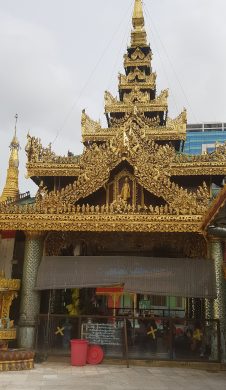 There are several temples that are worth a look-see, such as the one right in the middle of it all, Kheng Hock Keong Temple, which is dedicated to the goddess Mazu, who watches over fisherman and seafarers. It’s one of the largest and oldest Chinese folk religion temples, maintained by a community of Hokkien Chinese, and can be found on the corner of Sintodan and Strand roads.
There are several temples that are worth a look-see, such as the one right in the middle of it all, Kheng Hock Keong Temple, which is dedicated to the goddess Mazu, who watches over fisherman and seafarers. It’s one of the largest and oldest Chinese folk religion temples, maintained by a community of Hokkien Chinese, and can be found on the corner of Sintodan and Strand roads.  A visit to a temple or two gives you the chance to escape the hustle and bustle of the busy streets, to take some great photos, and to absorb the peace and quiet you find within. The major temple in this area is Sule Pagoda, 2nd in popularity only to the fantastic Shwedagon (which is also close by). Sule Pagoda is an ancient octagonal pagoda near 24th St, at the bottom end of Chinatown. This is a medium-sized temple, known locally as the Kyaik Athok Zedi, and is encompassed by busy streets, a market, and really cool British colonial era buildings, such as the Supreme Court and City Hall. These solid but stylish structures were built to last by the British, and are still proudly kept in a good state of repair by the citizens of Rangoon (Yangon), many of whom look back with fondness at their former rulers, the British. After so many years of harsh rule by their military dictatorship, it is not difficult to see why.
A visit to a temple or two gives you the chance to escape the hustle and bustle of the busy streets, to take some great photos, and to absorb the peace and quiet you find within. The major temple in this area is Sule Pagoda, 2nd in popularity only to the fantastic Shwedagon (which is also close by). Sule Pagoda is an ancient octagonal pagoda near 24th St, at the bottom end of Chinatown. This is a medium-sized temple, known locally as the Kyaik Athok Zedi, and is encompassed by busy streets, a market, and really cool British colonial era buildings, such as the Supreme Court and City Hall. These solid but stylish structures were built to last by the British, and are still proudly kept in a good state of repair by the citizens of Rangoon (Yangon), many of whom look back with fondness at their former rulers, the British. After so many years of harsh rule by their military dictatorship, it is not difficult to see why.
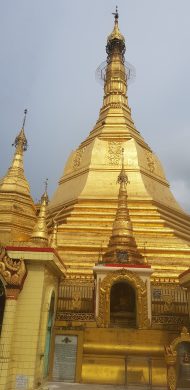 According to legend the pagoda was built during the lifetime of the Gautama Buddha himself, about 2,500 years ago. The pagoda was much smaller at the time. It has been renovated and enlarged several times by later kings, and the paya reached its present height when it was improved upon halfway through the 15th Century. The temple is named after Sularata, the Sule Nat (spirit) who lived at the spot where the pagoda now stands. According to legend Sularata, a spirit millions of years old, discovered the spot where relics of the three reincarnations of the Buddha were buried. Nat spirits have been worshipped for centuries in Burma, even before the arrival of Buddhism. Sule’s golden Mon style pagoda measures 44m high and differs from the norm, with its unusual octagonal shape, that continues all the way up to the spire. The pagoda is topped with a hti, a multi-tiered ornamental umbrella-shaped design, also seen on most temples in Thailand. The Sule Paya is especially revered because it contains a hair of the Buddha, and a steady flow of Burmese devotees, and visitors from other countries arrive daily to make merit and bring offerings.
According to legend the pagoda was built during the lifetime of the Gautama Buddha himself, about 2,500 years ago. The pagoda was much smaller at the time. It has been renovated and enlarged several times by later kings, and the paya reached its present height when it was improved upon halfway through the 15th Century. The temple is named after Sularata, the Sule Nat (spirit) who lived at the spot where the pagoda now stands. According to legend Sularata, a spirit millions of years old, discovered the spot where relics of the three reincarnations of the Buddha were buried. Nat spirits have been worshipped for centuries in Burma, even before the arrival of Buddhism. Sule’s golden Mon style pagoda measures 44m high and differs from the norm, with its unusual octagonal shape, that continues all the way up to the spire. The pagoda is topped with a hti, a multi-tiered ornamental umbrella-shaped design, also seen on most temples in Thailand. The Sule Paya is especially revered because it contains a hair of the Buddha, and a steady flow of Burmese devotees, and visitors from other countries arrive daily to make merit and bring offerings.
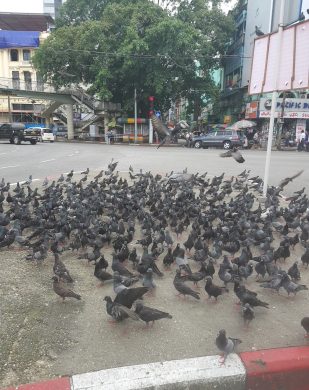 Several depictions of a Hintha bird can be spotted within the temple grounds. One of these mythological birds with a miniature pagoda on its back sits on top of a pole inside a lotus flower, while another with a shrine on its back hangs down from a steel cable, and it can be seen mechanically ‘flying’ up and down from the pagoda several times a day. The Sule Paya opens daily from 6am until 10pm. Entrance fee is 3USD per person. Foreign visitors are requested to make a donation in the range of 500 to 1,000 Kyat towards the upkeep of this wonderful place. Be a shame not to give them about 80 cents, huh.
Several depictions of a Hintha bird can be spotted within the temple grounds. One of these mythological birds with a miniature pagoda on its back sits on top of a pole inside a lotus flower, while another with a shrine on its back hangs down from a steel cable, and it can be seen mechanically ‘flying’ up and down from the pagoda several times a day. The Sule Paya opens daily from 6am until 10pm. Entrance fee is 3USD per person. Foreign visitors are requested to make a donation in the range of 500 to 1,000 Kyat towards the upkeep of this wonderful place. Be a shame not to give them about 80 cents, huh.
As evening approaches…
So, you’ve had your shopping fix, and your culture fix. What’s next? Well, Yangon’s Chinatown is known as a haven for foodies, and as evening approaches it becomes a food paradise.
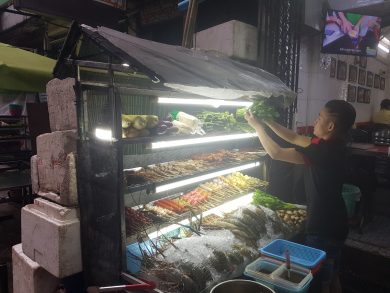 The king of the crop, though, is the barbecue heaven of 19th Street. From about five in the evening every day of the week, until after midnight, the 200m long street attracts throngs of locals and tourists to sit in their little shops, or outside on the street, where tables and chairs have been set up. There are scores of glass cabinets filled to the brim with cuts of meat (pork, duck, chicken), all manner of fish and seafood, and fresh vegetables, herbs, and spices, with each place having their own in-house designed sauce that brings their customers coming back for more.
The king of the crop, though, is the barbecue heaven of 19th Street. From about five in the evening every day of the week, until after midnight, the 200m long street attracts throngs of locals and tourists to sit in their little shops, or outside on the street, where tables and chairs have been set up. There are scores of glass cabinets filled to the brim with cuts of meat (pork, duck, chicken), all manner of fish and seafood, and fresh vegetables, herbs, and spices, with each place having their own in-house designed sauce that brings their customers coming back for more.
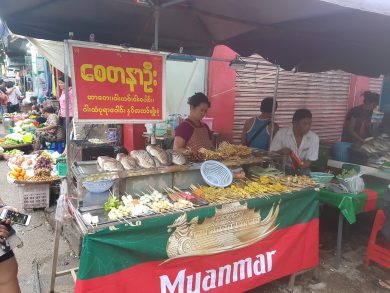
Once you have chosen where you want to sit you point out what you want, and your choices will be put into a basket, and taken away to be barbecued. Most of the time they are cooked right in front of you, well in sight of your table. While you are waiting for your meal to come, sit back and enjoy a Myanmar beer, which will be poured into an ice-cold glass taken out of a freezer. On my last trip I went for a whole fish (no idea what variety). I really liked the marinade and seasoning on the fish – it was stuffed with what looked like green chilies and maybe ginger, plus some other herbs, and it was rubbed in a red chilli paste, which was spicy, but not as spicy as my girlfriend from northern Thailand likes (which is way too hot for me). But my fish was just right.
On 19th Street the restaurants are always busy, and you are bound to meet someone to chat to… they could be from the other side of the world… or maybe even from your own home town – it happens there more than you might expect! After your night of feasting and drinking there is nothing left but head to your hotel and retire… replete and relaxed… to your hotel bed. Until next time!
Myanmar is on the up… there is something for everyone… hope to meet up with you there someday!



